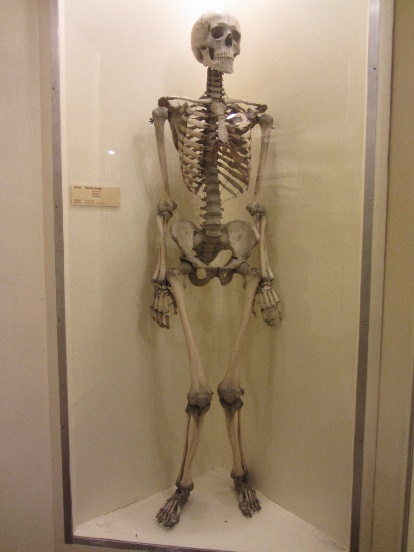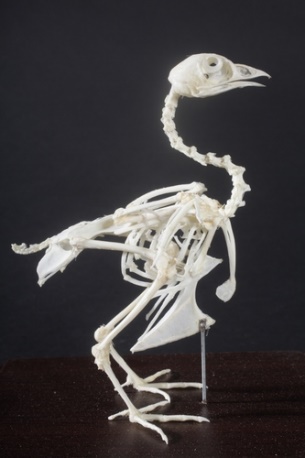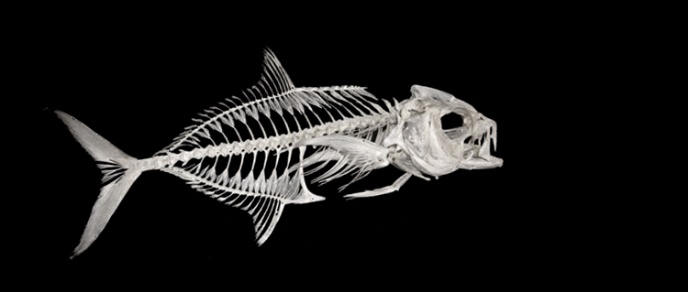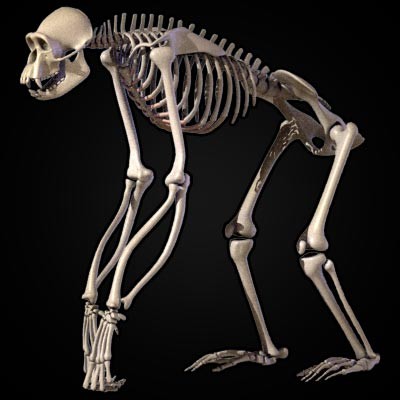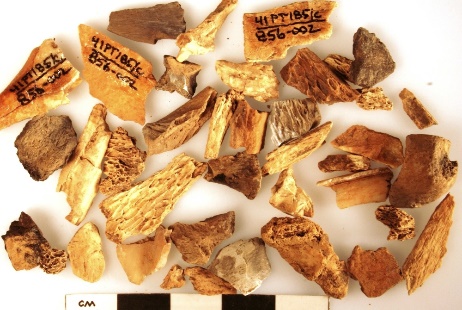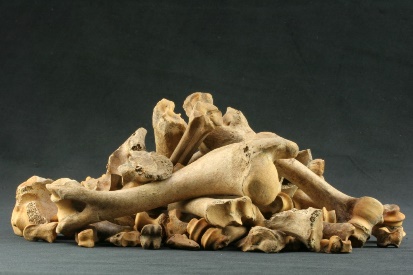According to the medical dictionary, bone is a hard and rigid connective tissue existing in most vertebrates, including mammals, fish, amphibians, reptiles, birds, primates, rodents and marsupials (Figure 1). Bone is one of the strongest biological material in existence, particularly in terms of bearing weight and giving support to the movement of the body.
It is important for Forensic Anthropologists, Physical Anthropologists and Archaeologists to identify human bones and differentiate them from non-human bones, i.e. artefacts and animal bones. For layman, this matter may sound trivial but for a scientist dealing with human bones, this question is very pertinent from the forensic viewpoint before embarking on any further investigation or research.
As shown in Figure 1 below, when the skeleton is in an intact condition, it is not difficult to identify the species of the bone. Unfortunately, in most cases, the bones are incomplete, fragmented, and even commingled (consisting more than one individual human skeleton or mixed with animal bones ) (Figure 2). Hence, identifying human bones is a critical step in every anthropological case.
There are various methods in differentiating human bones from non-human bones. Generally, it can be divided into three methods – macroscopic, microscopic and bio-chemical methods.
|
a) Human skeleton – adapted from http://animal-kid.com/fish-skeleton.html |
b) Bird skeleton – adapted from http://www.dappercadaver.com/products/small-bird-skeleton-quail.html |
c) Amphibian skeleton – adapted from http://scienceblogs.com/tetrapodzoology/2007/10/28/frogs-toads-sheer-untold-awesomeness/ |
|
d) Fish skeleton – adapted from http://animal-kid.com/fish-skeleton.html |
e) Reptile skeleton – adapted from http://searchpp.com/reptile-skeleton/ |
|
|
f) Primate skeleton – adapted from http://www.turbosquid.com/3d–models/chimpanzee-skeleton-3ds/654529 |
g) Rodent skeleton – adapted from https://www.flickr.com/photos/galleriejc/3979155157/ |
h) Marsupial skeleton – adapted from https://twitter.com/mvmammals/status/496534172471545856 |
Figure 1: Skeletons of different vertebrates.
Figure 2: When bones are not catalogued systematically, this will cause difficulty in identifying human bones.
Macroscopic Method
- Gross Visualization
In identifying human bones, it is recommended that the examiner has an intact comparative skeleton close at hand, even in remote fields. This is because human bones can be confused with many animal bones, especially primates, even though with experienced anthropologist.
Quoting Dr. William Bass, a renowned anthropologist, it is best to hold or touch the bone elements ourselves, as there is no illustration or description that is as good as comparing with actual bone. Secondly, one should familiarize himself/herself with as many animal bones as possible, especially animals that can be found in the local area or habitat where the skeletonised remains were found. This is important when encountering human bone-like structures as they can be very similar to animal bones or even artefacts like a dried twig or tree branch. There is noticeably subtle differences between human bones and animal bones as there are fine morphological variations in the bone features.
Schwartz and Schwartz produced a book called “The wild mammals of Missouri” in year 1959, which illustrates line drawings of animals as well as bones of the animals. This book can act as guide for the inexperienced anthropologist in distinguishing between human bones and non-human skeletal remains.
With good reference guide and from direct gross visualization, one can actually tell that it is human bones macroscopically without conducting further examination. For example, it is not difficult to differentiate between femora of a child with the femora of an adult dog as there will be no fused epiphyses in the child’s femur (Figure 3).

Figure 3: Femora of a 3-year-old child (180mm) (left) and an adult dog (166mm). They are of similar size, but the epiphyses of the adult dog have united whereas there are no fused epiphyses on the child’s femur. (Adapted from Robert, J., PPT: Forensic Anthropology, 2014) - Examination and Measurement
Besides gross visualisation of the bone elements, detailed examination of the size, shape, density and surface structure of bones using a hand held magnifying lense can also elicit morphological features of the bone.
According to Julie Robert, humans are bipeds whereas most animals particularly mammalians are quadrupeds, so a human being will possess the following features:
- Shorter ‘dish shaped’ pelvis.
- Present of foramen magnum at the base of cranium.
- Adaptations of hands and feet.
- 3 curves of the spine.
Julie Robert also mentioned that when comparing to humans, animals like horse, pig and cow have fused 3rd and 4th metacarpals as they have longer strides.
Moreover, due to the bipedal locomotive movement of humans, the joints of a human skeleton have a smoother and rounder joint surfaces. On the other hand, the joints present in the majority of animals are often more grooved with a central ridge and have a better interlocking shape.
Long bones of humans also possess great differences from long bones of animals, i.e. the cortical shaft of a human femur and humerus are thinner and the degree of curvature is lesser, while the femoral head angle of a human is usually greater than 90° as compared to the femoral head angle of an animal which is normally 90°.
Occasionally, measurements of the bone parameters, will give a clue on whether the bone is a human bone or not. Driesch and Moore-Jansen produced books on the detailed measurements of both animal and human bones. The information gathered from the measurements can be taken as a reliable guide in differentiating the bones when in doubt.
Microscopic Method
Microscopic examination is a method used especially when dealing with fragmented bones or pieces of remains. Normally, a trained bone histologist can carry out this examination with confidence.
According to Julie Robert, different species of animals including humans exhibit different patterns of osteons in the bone histology.
Similarly, Mulhern and Ubelaker mentioned in their research paper that the type of osteon banding present in the human and non-human samples are easily distinguishable between one another.
Bio-chemical Method
Last but not least, DNA analysis is the definitive method in identifying human skeletonised remains. Humans possess a certain number and set of chromosomes with a genetic makeup which is totally different from any other living organism. Hence, by analysing the DNA profile, it can determine with a reasonable scientific certainty that the bone specimen is of human or non-human.
In conclusion, one should not hesitate to consult an anthropological scientist/expert or request for further bone analysis when in doubt during the process of examining and identifying the skeletalised remains, particularly in dealing with fragmented bones pieces as any mistake will affect the professional service and justice system.
Differentiating Human Bones With Artefacts
Besides animal bones, artefacts is another common factor in causing confusion to the anthropologists in the identification of human bones. For example, chinawares, synthetic polymers, glasses andwood like twigs or tree branches can be deceiving and look almost similar to bones. Nevertheless, these artefacts can easily be singled out from actual bones by naked eye appearance as the surface textures and morphology are different from bone tissues. If one lack confidence in differentiating bones from artefacts, microscopic examination is a valuable tool to assist in differentiating between human / animal bones and non-living specimens as the latter will have no bone cells displayed.
References
- http://medical-dictionary.thefreedictionary.com/bone
- White, T.D., Folkens P.A., The Human Bone Manual, 2005
- (2) Bass, W., Human Osteology: A laboratory and field manual 5th edition, 2005
- (3) Robert, J., PPT: Forensic Anthropology, 2014
| Last Reviewed | : | 23 August 2019 |
| Writer | : | Chong Sin Leng |
| Accreditor | : | Dr. Nurliza bt. Abdullah |
| Reviewer | : | Dr. Khoo Lay See |


